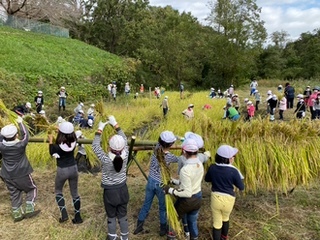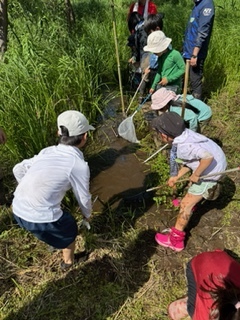Asaza Fund
The specified non-profit corporation Asaza Fund focuses its activities on the basins of Lake Kasumigaura and Lake Kitaura in Ibaraki Prefecture, and aims to become a model for a circular community by preserving and restoring “satoyama” (traditional rural forest) that are rapidly disappearing due to abandonment of farmland and population outflow, and improving the local environment and rebuilding places for human interaction through its activities with the aim of maintaining and revitalizing biodiversity and the local community. We spoke with Representative Director Iijima-san.

Children working on revitalizing the rice paddies in the valley near their school as part of their comprehensive studies
How did you become interested in the field you are currently working in?
My interest in environmental issues began when I was a junior high school student living in Tokyo. At the time, pollution issues such as Minamata disease were becoming widespread, and outside activities at school were sometimes canceled due to photochemical smog.
At the time, there were only eight Japanese crested ibises left on Sado Island, and it was frequently broadcasted that they would inevitably become extinct if left unprotected. Originally, Japanese crested ibises lived in areas such as satoyama and rice paddies throughout Japan and were a familiar creature to us. However, I was shocked to learn that they were being driven to extinction due to changes in the way humans live. I began to vaguely feel that I wanted to somehow change the way humans were putting a strain on the creatures and the environment around us, leading to the extinction of many species.
At the same time, the existence of Minamata disease had a major impact on me. I learned that someone who had been born with a severe disability called fetal Minamata disease was in the same age as me, and it felt like a familiar problem to me. The biggest victims of the Minamata problem were the local people who had made a living in harmony with waters of the Shiranui Sea. It's not the city dwellers who caused the pollution, but those who live in harmony with nature who are burdened with a kind of debt from civilization. This idea sprouted within me as a very big question when I was in junior high school. Since then, I have been self-studying about the environment and biology.
What is your motivation for getting involved in environmental issues?
When I was a child, there were still many satoyama even in the suburbs of Tokyo, and I played in the fields and mountains almost every day. I particularly remember that nature was a place where people lived, but also where many living creatures coexisted like people collecting fallen leaves in the scrub forests and cultivating shiitake mushrooms on the oak trees. These experiences remain with me as formative experiences and landscapes, and I want today's children to have similar experiences, so I continue to work to bring many children to satoyama forests. I also regularly travel to schools across the country to teach comprehensive studies, and the truly wonderful perspectives and opinions that emerge from the children are a source of inspiration. Without setting a specific theme, I draw out thoughts from the children and, in the process of deepening questions that arise within them, sometimes they come up with profound words that I would never have imagined through their interesting ideas in unexpected directions. This is my driving force and a major factor in why I have been able to continue our activity.

Children engrossed in searching for creatures in the valley rice paddies (medaka, loaches, yago, etc.)
What is the most memorable event that has happened in your career so far?
We began the Asaza Project in 1995, and rather than confining our efforts on solving environmental issues to a limited field, we wanted to create a system that would link all sectors, including agriculture, industry, education, and public works, and bring major changes to entire society.
We suggested to the Ministry of Land, Infrastructure, Transport and Tourism at that time with a proposal for a public project on the lake that would involve the participation of residents. This public project focused on returning Lake Kasumigaura, which had been paved over with concrete at the time, to its natural state, and involved improving the surrounding environment. In improving the surrounding environment, we invited the fishing cooperative, saying that improving the lake environment would lead to more fish, and we also approached the forestry cooperative, saying that using thinned wood from upstream forests would help forestry workers. We then invited farmers and consumer cooperatives to participate, and we also involved people as part of school education. As such, we began an initiative to improve the waterside environment with many people, and then, more than 10,000 people took part between 1995 and 2000. It was a truly groundbreaking event.
However, because this project was too successful in a short period of time, it caused a great deal of opposition among those involved, and the initiative ended as a one-off isolated case. Looking back now, I think there could have been other approaches at the time, but it was a good learning experience.
Please tell us how the donations from FIT are being used.
While the donations are also used for our satoyama experience initiatives, they are primarily used to purchase machinery. With the cooperation of supporting companies, we are redeveloping abandoned rice fields and cultivating rice. However, these valley rice paddies are just part of it, and we are also working to restore water sources over a wider area. As a result, with limited manpower, we are forced to rely on machinery. As the valley rice paddies are traditional rice paddies with spring water and deep mud, we cannot use conventional large machinery. We used the FIT donations to purchase machinery that can be used in such difficult conditions. Furthermore, since we do not use herbicides, weeding is a labor-intensive process. Furthermore, abandoned bamboo forests around water sources, if left unattended, will absorb all the water, preventing it from reaching the rice paddies. We are also working to reduce the number of such abandoned bamboo forests, and are exploring the possibility of turning these bamboo into chips and using them effectively for rice cultivation. We also purchased machinery to support these efforts.

A cultivator with basket wheels that is useful in deep muddy rice fields
Please give a message to those reading this article.
Many people are involved with FIT, and we would love to connect with people who are working on social issues in different fields. For example, we could invite children from a children's cafeteria and those involved to come to the valley rice fields and grow rice, even if it's just planting and harvesting. This way, everyone can secure pesticide-free rice to use themselves, and the children can experience satoyama.
We would love to connect people who are working on various social issues with the space we have created, and then connect something else to it, and create such ideas together.
The specified non-profit corporation Asaza Fund
http://www.asaza.jp

